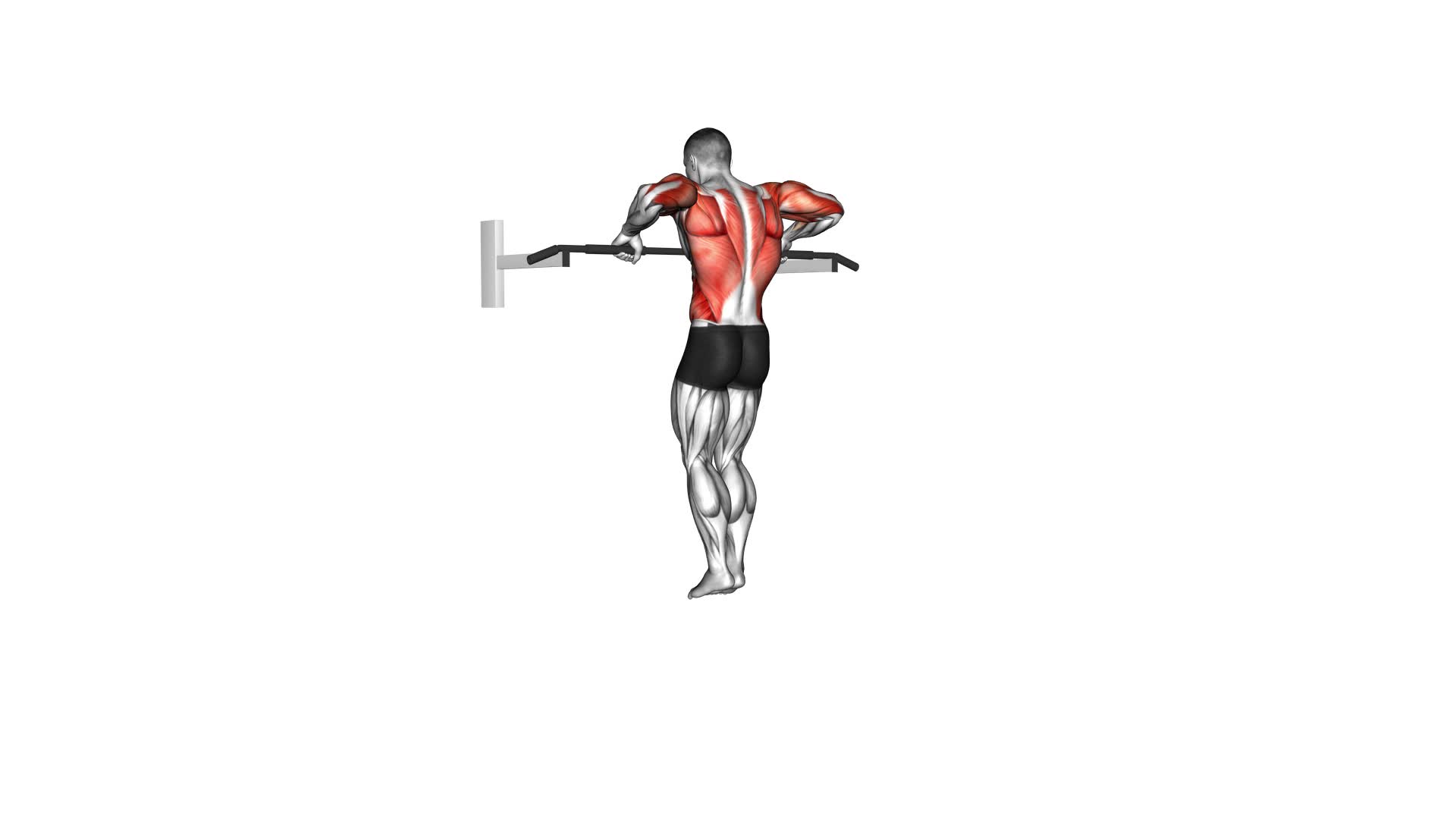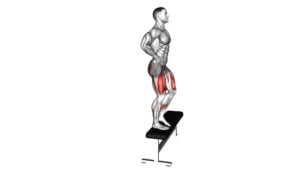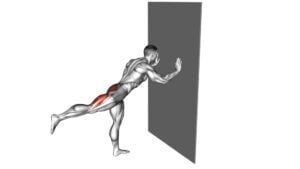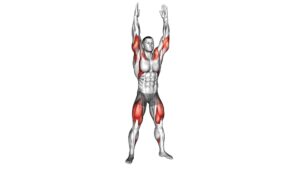Bodyweight Muscle-up (VERSION 2) – Video Exercise Guide & Tips

Are you looking to take your bodyweight exercises to the next level? Then the Bodyweight Muscle-up is the perfect challenge for you.
Watch This Exercise Video
In this video exercise guide, we will show you the proper technique and provide tips to improve your form. With just your body and a little practice, you can master this impressive exercise.
Get ready to strengthen your upper body and impress everyone with your new skills. Let's dive in!
Key Takeaways
- Bodyweight muscle-ups target multiple muscle groups in the upper body.
- Proper technique and form are crucial to prevent injury and maximize progress.
- Building upper body strength through exercises like push-ups, pull-ups, and dips is essential for achieving a muscle-up.
- Progressions, modifications, and tips can help individuals work towards a full muscle-up.
Benefits of the Bodyweight Muscle-up
Experience the numerous benefits of the bodyweight muscle-up and enhance your overall strength and muscle development.
The muscle-up is a highly effective exercise that targets multiple muscle groups in your upper body, including your chest, shoulders, back, and arms. By incorporating this exercise into your routine, you can expect to see improvements in your upper body strength, power, and muscular endurance.
One of the key benefits of the muscle-up is its ability to build functional strength. Unlike traditional weightlifting exercises that isolate specific muscles, the muscle-up requires a coordinated effort from your entire upper body. This translates into improved overall strength and the ability to perform real-life activities with ease.
Additionally, the muscle-up is a compound exercise that engages multiple muscle groups simultaneously. This not only saves time in your workout but also increases the intensity, leading to greater muscle development. It's an efficient exercise that targets your chest, shoulders, back, and arms all at once, helping you achieve a well-rounded physique.
To perform a muscle-up, you'll need a bar or rings to hang from. This is the only equipment necessary, making it a convenient exercise that can be done in a variety of settings. Whether you have access to a gym or prefer to workout outdoors, you can easily incorporate the muscle-up into your routine.
Equipment Needed for the Muscle-up
To successfully perform a muscle-up, there are a few essential equipment pieces you'll need.
These include:
- A pull-up bar, preferably one that's sturdy and secure.
- A set of gymnastic rings.
If you don't have access to rings, you can also use:
- A TRX suspension trainer.
- A sturdy set of parallel bars as alternatives.
Essential Equipment for Muscle-Up
You will need a few essential pieces of equipment to perform the muscle-up. The good news is that you don't need much, as the muscle-up is primarily a bodyweight exercise.
The first piece of equipment you'll need is a sturdy pull-up bar, preferably one that can support your body weight and provide a comfortable grip. Make sure the bar is securely mounted to a wall or ceiling.
Additionally, you may want to consider using gymnastic rings. Rings allow for more freedom of movement and can challenge your stability and coordination during the muscle-up. While not mandatory, they can enhance your training experience and provide a different muscle up variation.
With these essential pieces of equipment, you'll be well on your way to mastering the muscle-up.
Alternatives to Required Equipment
To perform the muscle-up without the required equipment, you can explore alternative options that still allow you to effectively train and develop the necessary strength and skills. If you don't have access to a pull-up bar or rings, you can try alternative exercises that focus on bodyweight training.
One option is the bar dip, which targets the triceps, chest, and shoulders. Another alternative is the explosive push-up, which helps build upper body strength and explosive power. Additionally, you can work on your pull-up strength by doing inverted rows, using a suspension trainer or a sturdy table.
These alternative exercises will help you develop the necessary strength and skills for the muscle-up, even without the required equipment.
Now, let's move on to discussing the proper technique for the bodyweight muscle-up.
Proper Technique for the Bodyweight Muscle-up
Mastering the bodyweight muscle-up requires a strong foundation of upper body strength and control. To execute this advanced exercise properly, follow these steps:
- Grip: Begin by gripping the bar with your palms facing away from you, slightly wider than shoulder-width apart.
- Pull-up: Initiate the movement by performing a powerful pull-up, driving your elbows down towards your hips.
- Transition: As you reach the top of the pull-up, explosively pull your chest towards the bar while simultaneously leaning back and tucking your knees towards your chest.
- Dip: Once you've completed the transition, push yourself up and over the bar by extending your arms and pushing your body away from the bar.
By following these bodyweight muscle up progressions, you'll be able to efficiently execute the exercise and avoid common muscle up mistakes.
Now, let's move on to the next section where we'll discuss the common mistakes to avoid when performing the bodyweight muscle-up.
Common Mistakes to Avoid
When attempting the bodyweight muscle-up, there are a few common mistakes to avoid.
One of the most overarching technique errors isn't maintaining a tight body position throughout the movement. This can lead to inefficiency and difficulty completing the exercise.
Additionally, insufficient upper body strength is another common mistake that can hinder your progress. It's important to focus on building strength in the shoulders, chest, and arms to successfully execute the muscle-up.
Overarching Technique Errors
One common mistake to avoid when performing the bodyweight muscle-up is failing to engage your core throughout the movement. This is crucial because a strong core provides stability and allows for a smooth transition between the pulling and pushing phases.
Here are some overarching technique errors to be aware of and avoid:
- Lack of shoulder mobility: Insufficient shoulder mobility can hinder your ability to properly perform the muscle-up. It's important to work on improving shoulder flexibility through exercises such as shoulder dislocations and mobility drills.
- Inadequate grip strength: Gripping the bar firmly is essential for maintaining control and generating power during the muscle-up. Make sure to strengthen your grip through exercises like dead hangs and farmer's walks.
- Insufficient pulling strength: Without enough pulling strength, you may struggle to get your chest above the bar during the muscle-up. Gradually progress through pulling exercises, such as chin-ups and pull-ups, to build the necessary strength.
- Lack of technique refinement: Focusing on proper technique is crucial for executing a successful muscle-up. Take the time to practice and refine your technique, paying attention to the timing and coordination of the movement.
Insufficient Upper Body Strength
To improve your bodyweight muscle-up technique and avoid common mistakes, it's essential to develop sufficient upper body strength. If you lack the necessary strength, attempting a muscle-up can lead to frustration and potential injury.
Fortunately, there are exercises specifically designed to help you build strength in your upper body. Push-ups are an excellent starting point, as they target your chest, shoulders, and triceps. As you progress, you can incorporate variations such as decline push-ups, diamond push-ups, and handstand push-ups to challenge your muscles further.
Pull-ups and chin-ups are also effective in developing upper body strength, especially in your back and arms. Additionally, practicing dips and inverted rows can help strengthen your triceps and back muscles.
Consistently incorporating these exercises into your workout routine will gradually improve your upper body strength, allowing you to perform a proper bodyweight muscle-up.
Progressions and Modifications for the Muscle-up
Start by gradually increasing your upper body strength and mastering basic pulling and pushing exercises. These progressions and modifications will help you work your way up to performing a muscle-up:
- Ring Rows: Begin by practicing ring rows to build strength in your back and arms. Start with an upright body position and gradually increase the difficulty by lowering the rings and increasing the angle of your body.
- Assisted Pull-ups: Use resistance bands or a spotter to assist you in performing pull-ups. This will help you build the necessary pulling strength for the muscle-up.
- Negative Muscle-ups: Start from the top position of the muscle-up and slowly lower yourself down to the starting position. Focus on controlling the descent and building strength in the transition phase.
- Transition Training: Practice the transition from the pull-up to the dip position. Use a low bar or rings to simulate the movement and gradually increase the difficulty as you get stronger.
By gradually progressing through these exercises and making modifications to suit your current strength level, you'll be able to work towards performing a full muscle-up.
Remember to always prioritize proper form and technique to prevent injury and maximize your progress.
Tips to Improve Your Muscle-up Form
To improve your muscle-up form, focus on maintaining proper body alignment throughout the entire movement. This is crucial for executing a smooth and efficient muscle-up.
One key aspect to consider is improving grip strength. A strong grip will allow you to maintain control and stability during the muscle-up. To enhance your grip strength, incorporate exercises such as dead hangs, farmer's walks, and towel pull-ups into your training routine.
Another important element to master is the false grip. The false grip involves placing your wrists over the bar rather than wrapping them around it. This grip allows for a more seamless transition from the pull-up to the dip portion of the muscle-up. Practice hanging from the bar with the false grip and gradually progress to performing pull-ups and dips using this grip.
Lastly, pay attention to your body alignment. Keep your core engaged, shoulders pulled down and back, and elbows close to your body throughout the movement.
Frequently Asked Questions
How Long Does It Take to Master the Bodyweight Muscle-Up?
To master the bodyweight muscle-up, it takes time and consistent training. The process differs for everyone, but with the right training techniques and practice, you can see progress.
Many people make common mistakes like neglecting proper form and rushing the movement. It's important to focus on building strength, mastering the necessary skills, and gradually progressing towards the muscle-up.
Stay dedicated, be patient, and you'll eventually conquer it.
Can I Do the Bodyweight Muscle-Up if I Have a Shoulder Injury?
If you have a shoulder injury and want to attempt the bodyweight muscle-up, it's crucial to consult a doctor first. They can assess your condition and provide guidance on whether it's safe for you to perform this exercise.
In the event that you're given the go-ahead, modifications can be made to accommodate your shoulder injury. These modifications might include using resistance bands or performing assisted variations of the muscle-up to reduce the strain on your shoulder.
Always prioritize your safety and follow professional advice.
What Muscles Does the Bodyweight Muscle-Up Work?
The bodyweight muscle-up is an excellent exercise that targets multiple muscles in your upper body. It primarily works your chest, shoulders, and triceps, helping to build strength and definition in these areas.
Additionally, it engages your back muscles, core, and forearms to stabilize and support your body throughout the movement.
To get the most out of this exercise, be sure to avoid common mistakes such as using momentum and neglecting proper form.
Are There Any Alternative Exercises That Can Help Me Progress Towards a Muscle-Up?
If you're looking for alternative exercises to help you progress towards a muscle-up, there are a few options you can try.
One exercise is the assisted pull-up, where you use a resistance band or a partner to help you.
Another exercise is the jumping muscle-up, where you use your legs to generate momentum.
How Often Should I Train the Bodyweight Muscle-Up to See Progress?
To see progress in your bodyweight muscle-up, it's important to train with the right frequency. Consistency is key here. Aim to train at least three times a week to allow your muscles to adapt and get stronger. However, don't overdo it. Rest days are just as important for recovery.
With regular training and proper rest, you should start noticing progress within a few weeks. Remember to listen to your body and adjust your training frequency accordingly.
Conclusion
In conclusion, the bodyweight muscle-up is a challenging exercise that offers numerous benefits for building upper body strength and coordination.
By using proper technique and avoiding common mistakes, you can improve your muscle-up form.
Progressions and modifications can also help you gradually work your way up to performing a full muscle-up.
Remember to incorporate these tips into your training routine to maximize your results and achieve a successful bodyweight muscle-up.

Author
Years ago, the spark of my life’s passion ignited in my mind the moment I stepped into the local gym for the first time. The inaugural bead of perspiration, the initial endeavor, the very first surge of endorphins, and a sense of pride that washed over me post-workout marked the beginning of my deep-seated interest in strength sports, fitness, and sports nutrition. This very curiosity blossomed rapidly into a profound fascination, propelling me to earn a Master’s degree in Physical Education from the Academy of Physical Education in Krakow, followed by a Sports Manager diploma from the Jagiellonian University. My journey of growth led me to gain more specialized qualifications, such as being a certified personal trainer with a focus on sports dietetics, a lifeguard, and an instructor for wellness and corrective gymnastics. Theoretical knowledge paired seamlessly with practical experience, reinforcing my belief that the transformation of individuals under my guidance was also a reflection of my personal growth. This belief holds true even today. Each day, I strive to push the boundaries and explore new realms. These realms gently elevate me to greater heights. The unique combination of passion for my field and the continuous quest for growth fuels my drive to break new ground.



